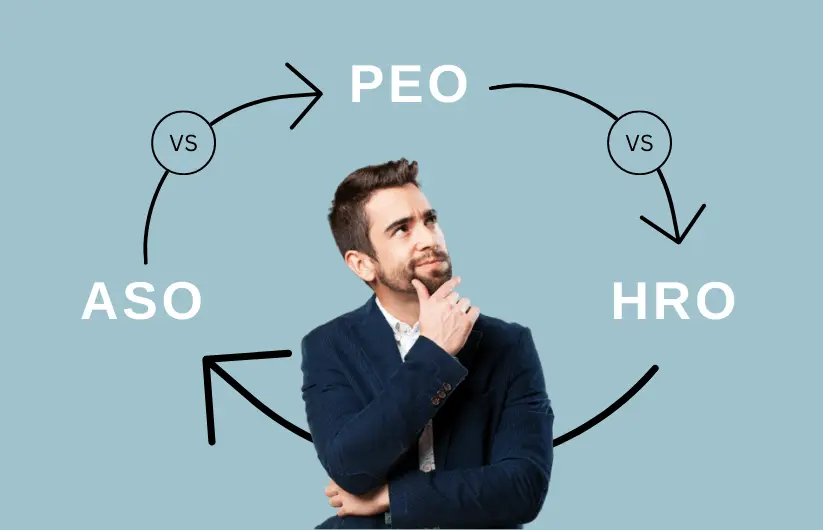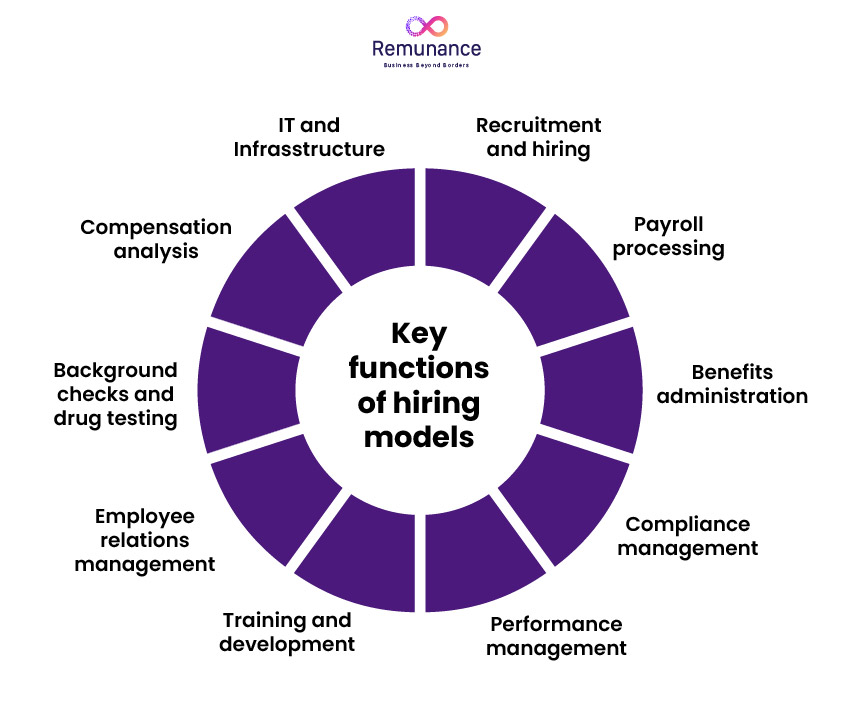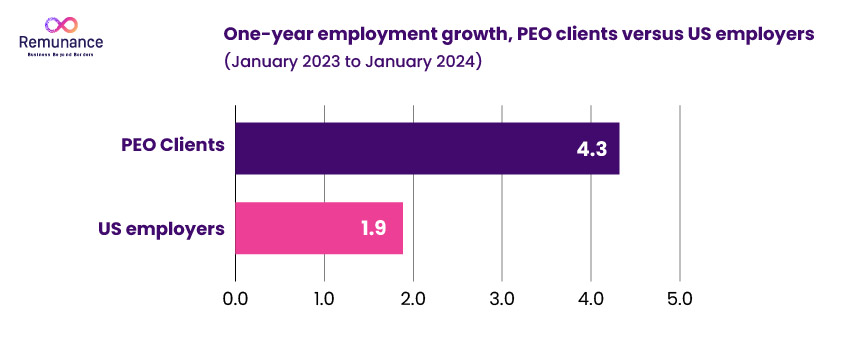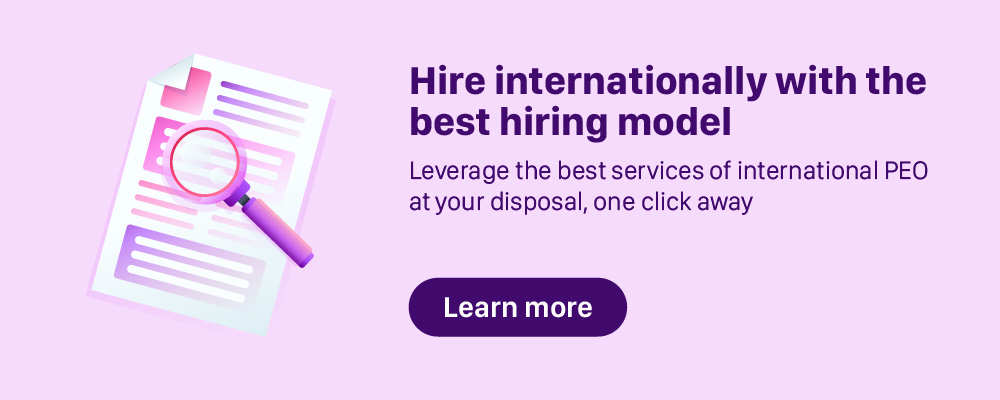Summary In this comparison of PEO vs. ASO vs. HRO, it’s discovered that while the models may sound similar, they have distinct differences. Varied business needs could demand different types of models and understanding each model well helps you choose the right model.
Have you been confused about the best hiring solution when comparing PEO vs. ASO vs. HRO? Each model seems similar and you don’t know which is right for your business. Well, you’re in the right place if you want a clarified understanding. Hiring solutions like Professional Employer Organisation (PEO), Administrative Services Organization (ASO), Human Resource Outsourcing (HRO), etc., are a great way to expand your business. And expand while offloading the HR and administrative work. It’s a smart way to do business; many big or small companies don’t hesitate to outsource these functions using one of these models. That being said, today in this blog, we dissect the topic of PEO vs. ASO vs. HRO. By the end of this blog, I hope you have your answers and that one hiring model best suited for your company.
Understanding the Basics: PEO vs ASO vs HRO
Before we get into the nitty-gritty, let’s understand the meaning and a basic distinction between each hiring model.
What do these hiring models do?
A common denominator in PEO vs. ASO vs. HRO is that they all help you manage the burden of your HR and administrative tasks. The ideal model differs based on various factors. For example, hiring employees in a different state but same country – and local PEO is your choice. But you don’t want to enter into co-employment and ASO is your choice. That is one of the main factors when comparing the difference between PEO and ASO. We’ll be understanding more of that as we go ahead.
What is Professional Employer Organisation (PEO)?
A professional employer organization is a company that takes responsibility for your HR administration tasks. The key feature of a PEO is that it manages your HR functions by becoming your co-employer. The administrative and legal responsibilities are shared with your PEO partner as they manage employee-related compliance. However, you get to retain complete control over the day-to-day operations of your employees. Read: What Is a PEO and How Can It Help Your Business Grow?
What is Administrative Services Organization (ASO)?
An administrative services organization is a company that solely manages your HR administrative tasks. A key difference between PEO vs. ASO is – an ASO has no co-employment or shared legal responsibilities. In fact, the term ASO was coined by the PEO industry in the late 1990s. The purpose was to separate the two and highlight the difference between ASO which was selective in the services offered, and PEO which was more full-scale suite.
What is Human Resources Outsourcing (HRO)?
A human resources outsourcing company helps you outsource some or all of your HR functions. Unlike an ASO which stays limited to a local market, an HRO can stretch its scope internationally. Comparing PEO vs. HRO, with an HRO, you retain ownership of both your legal responsibilities and control of your employee operations. One major difference between ASO & PEO vs HRO is that an HRO helps you hire internationally.
In breaking down PEO vs. ASO vs. HRO, we now come to the pros and cons of each model. We also get the answer to an important question as a business – when can you use it? This should help you get a clear idea of which model may suit you best.
How does Professional Employer Organization (PEO) work?
A whitepaper published by NAPEO states the companies that choose PEO services grow more than twice as fast as other companies. Let’s understand why.
Advantages
- With a PEO, you can establish a strong local presence all across the country. It helps you hire top talent, optimize your workflow locally, and basically keep you at the top of your game.
- Your local PEO partner can help you better navigate the cultural sensitivities of different locations. It helps you maintain a healthy work environment
- As a PEO shares co-employment with you, they are responsible for local compliance related to your employees, their benefits, and assistance with tax administration.
- The whitepaper by NAPEO mentions that employee turnover for PEO clients is 12% lower than other companies. This is because the PEO shares and takes responsibility for the engagement, retention, and motivation of your employees.
Disadvantages
- A PEO often offers services that are compiled in packages. This reduces the customization of services requiring you to choose from their predetermined service packages. For instance, payroll and benefits administration are something PEOs have in all their packages.
- Since a PEO is your co-employer, it takes on the control of certain internal HR processes and policies. This requires you to operate those said functions according to their standards.
When to use PEO?
- A PEO is a great option if you are an SME with limited internal HR expertise and resources. It is like an HR department in a box that you don’t have to build and spend on by yourself.
- This model works best if you have specific local market needs. It can help you hire anyone from construction workers to people in legal or manufacturing industries.
- Since a PEO is a co-employer with you, it is one of the best models if you want to share/reduce your compliance risks. You can easily leave all employee compliance to your PEO partner. Meanwhile you take care of other compliance related to your business or your local entity.
- If you want to expand to different states within the same country, without setting up offices in selected states, this model is your answer. It offers that added support which reduces the burden on your internal HR team.
How does Administrative Services Organization (ASO) work?
Advantages
- One major point in PEO vs ASO is that you don’t enter co-employment with an ASO. And hence, you don’t lose any control over your employees and HR administration as you are setting your own policies and doing your own compliance,
- Comparing PEO vs ASO, an ASO model offers a much more selective range of services. You can customize the scope of services you require and create the package that suits you best.
- Unlike a PEO, here you can hire the services of a full internal HR team saving you costs to hire any HR personnel in-house.
- An ASO can allow you to hire freelancers and independent contractors as they can manage their administration and payment, which can be a difficulty with some PEOs.
Disadvantages
- ASOs often charge a flat fee per employee, which can get expensive if not managed properly.
- While you can outsource all HR functions to an ASO, it may also cause reduced employee engagement and increased turnover. Impersonal communication can make employees feel undervalued as there would be no direct relationships.
When to use ASO?
- An ASO model is the best option if you’re looking to expand your operations, but are not hiring at scale.
- You can choose ASO if you need a cost-effective alternative to a full-service PEO.
How does Human Resources Outsourcing (HRO) work?
Advantages
- High savings on costs as you may not need an in-house HR team at all. You’ll still need a legal team to oversee your legal administration. However, the total costs will still be less.
- An HRO model can provide compliance for both your onshore and offshore teams. They are experts in international laws and also know the depths of local laws.
- In PEO vs. ASO vs. HRO, HRO is the strongest option if you want access to talent acquisition. Human resources outsourcing not only helps you hire local talent but allows global expansion too. Meaning, with an HRO, you can hire globally.
Disadvantages
- With an HRO, you can often face the risk of hidden charges if you’re not upfront about transparent pricing.
- Since the company shares sensitive employee and company data with the HRO partner, there can be a risk of data breaches if strong cybersecurity measures are not in place.
- One point similar between PEO vs HRO is that both models offer less control over the HR operations you outsource.
When to use HRO?
- You can choose HRO if you want to outsource specific tasks and not the entire HR function.
- HRO is a great model to go with if you need enterprise-level HR support.
- Since HRO companies function on a global level, they have the most advanced tech solutions. This is a great choice if you want high-end tech support without any investment.
- Between PEO vs ASO vs HRO, an HRO model is the one that will offer you multi-country support. You can hire in any country you wish to expand to.
I would like to bring your attention to another model that offers multi-country support – international PEO. With an HRO, you still bear most of the legal and compliance burden, as you are the legal employer.
An international PEO is a more global version of PEO. Here, your global PEO partner assumes complete legal responsibility and becomes an employer of record for all your employees. For example, you wish to hire employees in India.
To successfully hire in India, one crucial step would be to make sure you choose the best employer of record. Your international PEO partner will take care of every compliance that concerns your employees in this country.
What is the difference between PEO vs ASO vs HRO?
After understanding the scope of each HR model, let’s jump to the differences between PEO vs ASO vs HRO.
| Services | PEO | ASO | HRO |
| Co-employment | Yes | No | No |
| Legal liability | Shared liability | No | No |
| Risk management | Yes | No | Yes |
| Payroll processing & tax filing | Yes | Yes | Yes |
| HR compliance & employment law support | Yes | Yes | Yes |
| Benefits administration & insurance | Yes | Yes | Yes |
| Recruiting and talent acquisition | Yes | No | Yes |
| Employee onboarding and training | Yes | Yes | Yes |
| HR services customization | Yes | No | Yes |
| International hiring & HR support | No | No | Yes |
| Background checks & testing | Yes | Yes | Yes |
| Full outsourcing of HR functions | No | Yes | Yes |
| Employment contracts | Yes | No | No |
Conclusion
And with that we reach the end of the blog. We’ve seen the striking differences between PEO vs ASO vs HRO. And by now, I hope I have answered the question of which model suits your needs the best.
- Local PEO for services in the local market with co-employment
- ASO for services in the local market without co-employment, and
- HRO for international markets without co-employment.
- We also discussed international PEO, which is for international hiring and with co-employment.
But if I were to leave you with an opinion of mine, someone who’s analyzed the topics to the grain, this is what I would suggest –
- If you’re a startup – PEO would be a great choice. You share responsibility and you get expert guidance.
- If you’re a small or mid-sized company – PEO vs. ASO will work just fine.
- If you’re a business of any size looking for international expansion – international PEO would be a better bet over HRO.
And voila! Happy hiring!







 Schedule a free call
Schedule a free call